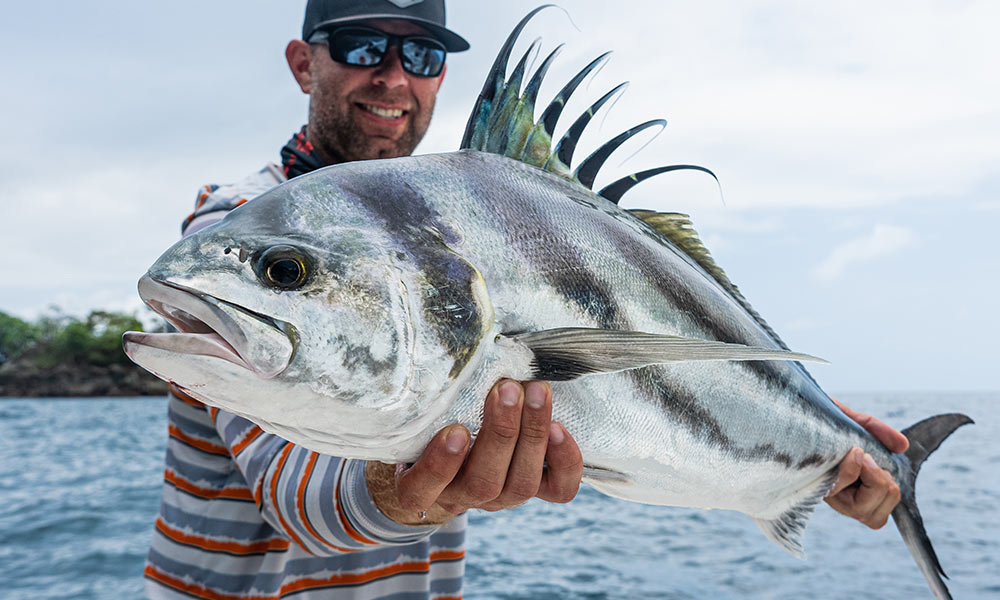Discover the best roosterfish destinations, guided trips, and lodge-based experiences worldwide. Explore remote waters and world-class angling with expert local hosts.

No results available
Roosterfish are one of the most sought-after inshore gamefish in the Americas—powerful, aggressive, and unmistakable with their comb-like dorsal fin. These predators haunt surf zones, rocky points, and nearshore drop-offs from Mexico to Peru.
Roosterfish (Nematistius pectoralis) are prized for their visual takes, explosive power, and willingness to chase surface baits. Most are targeted along Pacific coastlines from small boats or while casting from the beach. They thrive in warm, tropical waters with rocky structure, current seams, and bait-rich surf.
While fly anglers do pursue roosterfish—especially from boats in Baja and Central America—the majority are caught on spinning gear using live bait, poppers, or stickbaits. Fights are powerful and erratic, with the fish often making blistering runs into open water or down the beach. Sight-fishing is common, especially when they push bait close to shore.
Roosterfish are not valued for food and are typically released, especially larger specimens. Conservation awareness has grown in recent years, with many lodges promoting catch-and-release practices for this iconic species.
Colombia’s Pacific coast, particularly the Chocó region, offers remote access to healthy roosterfish populations. Lodges here provide guided boat access to surf zones, rocky outcrops, and current-heavy points where roosterfish actively hunt.
Both the Nicoya Peninsula and Osa Peninsula offer year-round roosterfish action. Most fish are caught from pangas using live bait or topwater lures along rocky shorelines and river mouths.
The Pacific side of Panama produces some of the largest roosterfish in the world. Isla Coiba and the Azuero Peninsula are standouts, with a mix of beach and boat access to productive waters.
The Sea of Cortez is legendary for sight-fishing roosterfish from beaches or small boats. Anglers use poppers, baitfish flies, and bait to target cruising fish in shallow water—often within casting range of shore.
Inshore waters off southern Ecuador and northern Peru hold roosterfish, though they’re less consistently targeted. When conditions align, these regions can produce large, aggressive fish near surf and rocky points.
Roosterfish offer one of the most exciting visual bites in saltwater. Whether slashing at a live bait or chasing down a popper, they strike with intensity and fight with speed. Their appearance is unmistakable—long, flowing dorsal rays and powerful, muscular builds. Because they cruise shallow water and hunt near structure, they’re a favorite for sight and topwater anglers. Few fish deliver such a visual, athletic fight so close to shore.
Roosterfish are built for speed and power, with a long, muscular body and a tall comb-like dorsal fin that gives them their name. The seven spines often trail behind as they cruise the surf. Their metallic silver sides are marked with bold vertical stripes, and their steep forehead and blunt jaw give them a strong, unmistakable profile. Most weigh 10–40 pounds, but fish over 60 pounds are fairly common in Panama and Costa Rica.
Roosterfish are more active when bait is pushed nearshore, especially in warm, stable water with light wind and good visibility. Mornings and late afternoons often provide the best surface action.
FishingExplora features lodge-based roosterfish trips in Colombia, where anglers access rugged coastlines, river mouths, and surf zones with experienced guides. These trips emphasize inshore action, sight-fishing, and powerfully built fish that define Pacific coastal angling. Roosterfish may be the ultimate nearshore target for anglers who want aggressive takes, fast fights, and an unforgettable visual experience.
Roosterfish commonly weigh 10–40 pounds, with trophy fish reaching 60 to 80 pounds. Panama and southern Costa Rica are known for producing some of the largest individuals.
Roosterfish are not considered good table fare. Their meat is coarse and often dark. Most anglers release them, especially larger fish, to support healthy populations.
Yes. Roosterfish aggressively strike topwater lures like poppers and stickbaits. When they’re feeding nearshore, visual strikes are common and often spectacular.
Top regions include Costa Rica, Panama, Baja, and Colombia. These areas offer reliable access to rocky coastlines, surf zones, and bait-rich inshore structure.
Heavy spinning gear with fast action rods is ideal. Use 30–50 lb braid and strong leaders. Roosters hit hard and run fast, often near structure—gear needs to be tough.